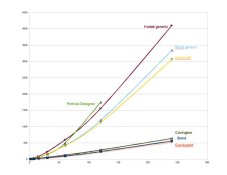Hi,
The most difficult part of nailing pinhole exposures is figuring for reciprocity failure during long exposures.
The rest is straightforward if you have an approximate f stop.
IMO, you should figure this through tests to find working shutter speeds at certain EVs, rather than precise exposures factoring in awesome reciprocity charts. Figure out how long an exposure you need to get a good exposure at a certain incident exposure value, then keep notes. It's easier than figuring exact reciprocity characteristics (though basically the same idea), and makes more sense practically for a pinhole camera.
For instance, say your incident meter reads EV 15 give or take: sunny 16 conditions. Say your film is ISO 125. You expose at about f/16 at '125 for sunny 16. Your f stop, let's say, is f/360. Count f stops from 16 to 360: 22, 32, 45, 64, 90, 128, 180, 256, 360 = nine stops from f/16. So, count down nine shutter speeds from '125: '60, '30, '15, '8, '4, '2, 1, 2, 4. Thus, the equivalent exposure for sunny 16 at f/360 is four seconds.
When you go to take your pix the first time, write down the EV your meter read, or the lighting conditions if you don't use a meter, and its recommended shutter speed for your f stop. However, bracket using longer exposures, and take note of which ones are which. Look at your developed negatives. Contact print them on filters 2 or 2.5, or grade 2 paper, to a density that makes the film edges zone 0 after the paper dries. Pick the one that gives you the amount of detail that you will generally want in the shadows. Look at your notes to see what the shutter speed was. In the future, that is your actual shutter speed for sunny 16. You can do this same thing every time you encounter a different EV, and gradually you can build a direct-reading chart of shutter speeds for each EV. You must make a new chart for each camera and each film, of course.
You can also use the same contact prints to determine good developing times for these compensated exposures.





 )
)
